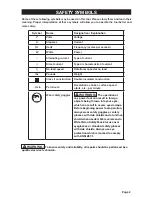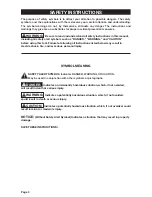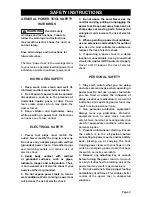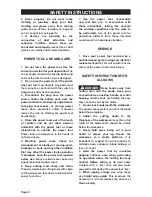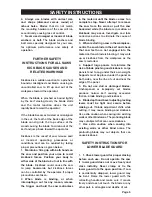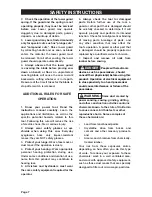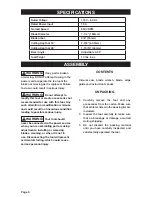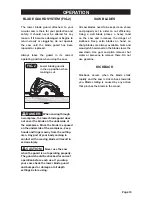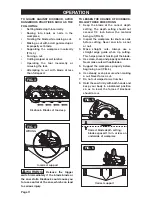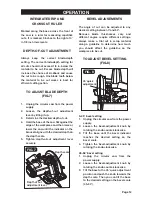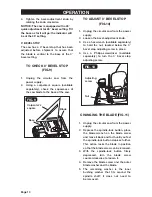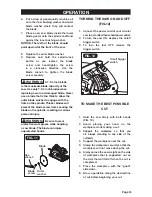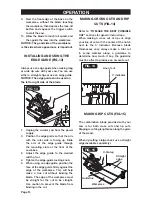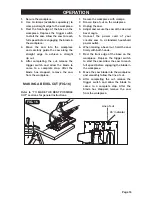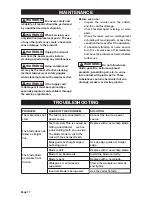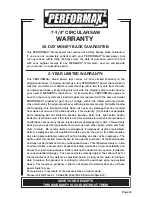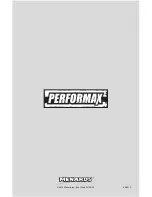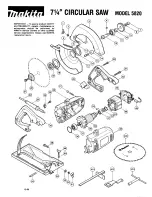
Page 6
SAFETY INSTRUCTIONS
6.
Always use blades with correct size
and shape (diamond versus round) of
arbour holes.
Blades that do not match
the mounting hardware of the saw will run
eccentrically, causing loss of control.
7.
Never use damaged or incorrect blade
washers or bolt.
The blade washers and
bolt were specially designed for your saw,
for optimum performance and safety of
operation.
FURTHER SAFETY
INSTRUCTIONS FOR ALL SAWS
KICK BACK CAUSES AND
RELATED WARNINGS
Kickback is a sudden reaction to a pinched,
bound or misaligned saw blade, causing an
uncontrolled saw to lift up and out of the
workpiece toward the operator;
When the blade is pinched or bound tightly
by the kerf closing down, the blade stalls
and the motor reaction drives the unit
rapidly back toward the operator;
If the blade becomes twisted or misaligned
in the cut, the teeth at the back edge of the
blade can dig into the top surface of the
wood causing the blade to climb out of the
kerf and jump back toward the operator.
Kickback is the result of saw misuse and/
or incorrect operating procedures or
conditions and can be avoided by taking
proper precautions as given below.
1.
Maintain a firm grip with both hands on
the saw and position your arms to resist
kickback forces. Position your body to
either side of the blade, but not in line with
the blade.
Kickback could cause the saw
to jump backwards, but kickback forces
can be controlled by the operator, if proper
precautions are taken.
2.
When blade is binding, or when
interrupting a cut for any reason, release
the trigger and hold the saw motionless
in the material until the blade comes to a
complete stop. Never attempt to remove
the saw from the work or pull the saw
backward while the blade is in motion or
kickback may occur.
Investigate and take
corrective actions to eliminate the cause of
blade binding.
3.
When restarting a saw in the workpiece,
centre the saw blade in the kerf and check
that saw teeth are not engaged into the
material.
If saw blade is binding, it may walk
up or kickback from the workpiece as the
saw is restarted.
4.
Support large panels to minimise the
risk of blade pinching and kickback.
Large
panels tend to sag under their own weight.
Supports must be placed under the panel on
both sides, near the line of cut and near the
edge of the panel.
5.
Do not use dull or damaged blades.
Unsharpened or improperly set blades
produce narrow kerf causing excessive
friction, blade binding and kickback.
6.
Blade depth and bevel adjusting locking
levers must be tight and secure before
making cut.
If blade adjustment shifts while
cutting, it may cause binding and kickback.
Use extra caution when sawing into existing
walls or other blind areas. The protruding blade
may cut objects that can cause kickback.
7.
Use extra caution when sawing into
existing walls or other blind areas.
The
protruding blade may cut objects that can
cause kickback.
SAFETY INSTRUCTIONS FOR
LOWER BLADE GUARD
1.
1. Check lower guard for proper closing
before each use. Do not operate the saw
if lower guard does not move freely and
close instantly. Never clamp or tie the
lower guard into the open position.
If saw
is accidentally dropped, lower guard may
be bent. Raise the lower guard with the
retracting handle and make sure it moves
freely and does not touch the blade or any
other part, in all angles and depths of cut.



